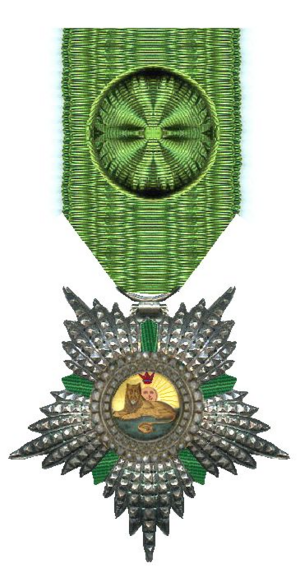Order of the Lion and the Sun
Appearance
You can help expand this article with text translated from the corresponding article in French. (January 2016) Click [show] for important translation instructions.
|
| Order of the Lion and the Sun | |
|---|---|
 Officer's Medal of the Order | |
| Awarded by Head of the Iranian Imperial Family | |
| Type | Dynastic Order |
| Royal house | House of Pahlavi |
| Sovereign | Crown Prince Reza of Iran |
| Grades | Knight/Dame Grand Cordon, Knight/Dame Grand Officer, Knight/Dame Commander, Knight/Dame Officer, Knight/Dame, Companion |
| Former grades | Knight Grand Cross with Collar |
| Precedence | |
| Next (higher) | Order of Aqdas |
| Next (lower) | Order of the Crown Order of the Pleiades |
Ribbon of the Order | |

The Imperial Order of the Lion and the Sun was instituted by Fat’h Ali Shah of the Qajar Dynasty in 1808 to honour foreign officials (later extended to Persians) who had rendered distinguished services to Persia. In 1925, under the Pahlavi dynasty the Order continued as the Order of Homayoun with new insignia, though based on the Lion and Sun motif. This motif was used for centuries by the rulers of Persia, being formally adopted under Mohammad Shah.
The order is abbreviated as KLS, for Knight of Lion and Sun.[1]
The order was senior to the Order of the Crown. It was issued in five grades.
Foreign recipients
Major-General Sir John Malcolm was the first foreign recipient in 1810. Other foreign recipients include:
- Maksud Alikhanov-Avarsky (1846—1907), Russian Lieutenant-General (1884, 1900 & 1902)
- Richard Wellesley, 1st Marquess Wellesley (1811)
- Sir Gore Ouseley (1770–1844), British ambassador to Persia and oriental scholar (1812)
- General Nikolay Rtishchev (1754-1835), Russian signatory to the Treaty of Gulistan (1813)[2]
- Major-General Sir Henry Lindsay Bethune (1787–1851), commander of Persian infantry regiments (1816)
- General Aleksey Petrovich Yermolov (1777—1861), Russian ambassador to Persia 1817 (1817)
- Sir Robert Ker Porter (1777–1842), artist and diplomat (1819)
- Sir Henry Rawlinson, 1st Baronet, (1810 - 1895)
- Charles Maurice de Talleyrand-Périgord (1821)
- Lieutenant-Colonel Sir Henry Willock, British envoy to Persia 1815–1826 (1826)
- Field Marshal Ivan Paskevich (1782–1856), Russian soldier (1828)
- Lieutenant-Colonel Sir John Kinnear MacDonald, British envoy to Persia 1826–1830 (1828)
- Abbasqulu ağa Bakıxanov Qüdsi, Azerbaijani writer, historian, journalist, linguist, poet, and philosopher (1829)
- Alexander Griboyedov (1795–1829), diplomat and playwright, Russian ambassador to Persia 1829 (1829)
- Camillo Benso, Count of Cavour, Prime Minister of the Kingdom of Sardinia and Kingdom of Italy
- Sir John McNeill, British Envoy to Persia 1836–1842 (1833)
- Sir Mancherjee Merwanjee Bhownaggree, KCIE
- Sir George Hayter (1792–1871), British portrait painter
- Armand Trousseau, French medical scientist
- Heinrich Alfred Barb, Austrian scholar, interpreter and scholar of the Persian language
- Marshal François Achille Bazaine (1811–1888), French soldier
- Brigadier-General Alexandre Percin, French soldier[3]
- Seth Apcar
- Arthur Upham Pope
- Sir Albert Abdullah David Sassoon (1889)
- Henry Blosse Lynch[4]
- Thomas Kerr Lynch[4]
- General Sir Albert Houtum-Schindler
- Honourable Lennox Hannay Lindley, MB, Chief Physician to the Shah of Persia (First class, 1902)[5]
- Garabet Hagopian (1906)[6]
- Karl Georg Graf Huyn (1909)
- Brigadier-General Hugh Bateman-Champain (1920)[7]
- Edward Granville Browne (1922)
- Major-General Sir Frederick Sykes
- General Władysław Anders,[8] commanding officer of 2nd Polish Corps in World War II
- Ernest Yarrow, Christian missionary and a witness to the Armenian Genocide
- Surveyor Hamid Gul, part of Turco-Persian Frontier Commission (1914). He was later awarded the title of Khan Sahib by the Viceroy & Governor General of India in 1918.
- General Boris Möller, Swedish gendarmerie officer (1914–1915)
- Baron Eric Hermelin, Swedish translator of classical Persian poetry (1943)
- Sir Francis Michie Shepherd (1892-1962), British Ambassador to Persia, 1950–1952.
In literature
- Anton Chekhov has a short story titled The Lion And The Sun. The story is about a mayor who had "long been desirous of receiving the Persian order of The Lion and the Sun".[9]
See also
Notes
- On 6 September 1900, the mayor of Mariánské Lázně, Dr. Nadler, was decorated with the Commander Cross of the Lion and the Order of the Sun by the Shah during an official visit.
References
- ^ Kaye, Jonn William (1856). The life and correspondence of Major-General Sir John Malcolm, G. C. B., late envoy to Persia, and governor of Bombay. London: Smith, Elder and Co. pp. 31–32. Retrieved 31 July 2018.
- ^ Mikaberidze 2005, p. 341.
- ^ Percin Ordre du Lion et du Soleil
- ^ a b J.M. Hammond. Battle in Iraq: Letters and Diaries of the First World War, p. 25
- ^ "No. 27431". The London Gazette. 16 May 1902. p. 3011.
- ^ "Army and Navy Gazette". Army and Navy Gazette. 24 November 1906.
- ^ The Gazette, supplement 705
- ^ "Wladyslaw Anders". Retrieved 2016-07-22.
- ^ http://www.ibiblio.org/eldritch/ac/jr/140.htm
Sources
- Mikaberidze, Alexander (2005). Russian Officer Corps of the Revolutionary and Napoleonic Wars. Casemate Publishers. ISBN 978-1611210026.
{{cite book}}: Invalid|ref=harv(help)
External links
Wikimedia Commons has media related to Order of the Lion and the Sun.

